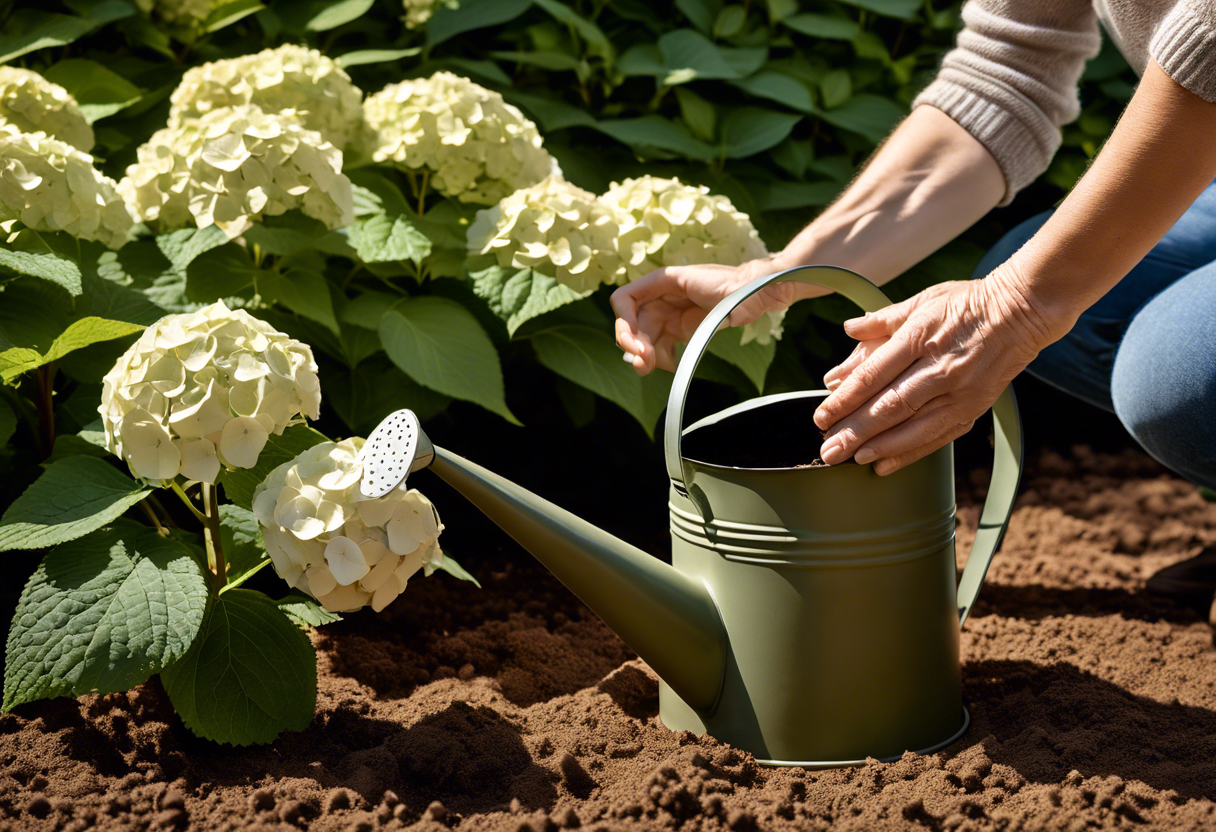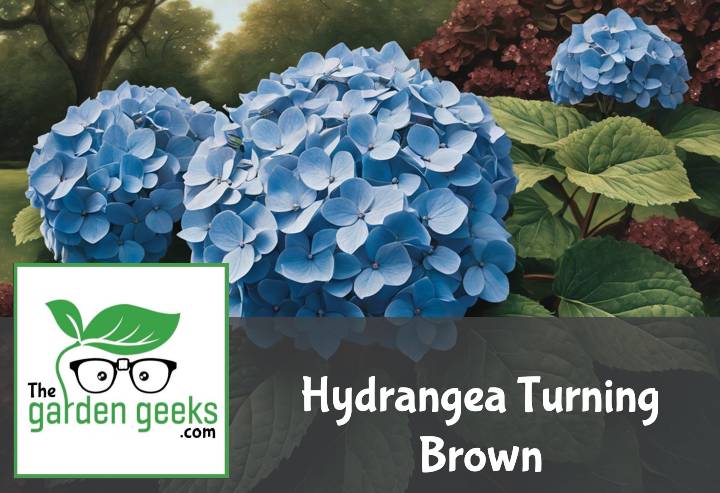Ever found yourself staring at your once vibrant Hydrangea Turning Brown and wondering where you went wrong? Trust me, I’ve been there. One day they’re blooming like a champ, the next they’re brown and droopy. It’s enough to make a grown gardener cry!
But don’t pull out your hair just yet! There are solutions that actually work to bring your hydrangeas back to life. Keep reading about ‘Hydrangea Turning Brown? (6 Solutions That Actually Work)’. You’ll be sporting green thumbs in no time!
Key Takeaways
- Hydrangeas turn brown due to overexposure to sun, lack of water, frost damage, or disease.
- To prevent browning, ensure the plant is in a shaded area with well-drained soil.
- Regular watering is crucial but avoid overwatering as it can cause root rot.
- Protect hydrangeas from frost by covering them or moving them indoors during cold weather.
- Treat diseases using appropriate fungicides and remove any diseased parts promptly.
- Proper pruning can also help maintain the health of your hydrangea.

Understanding Why Hydrangea Turns Brown
Let’s dive into the nitty-gritty of why your Hydrangea Turning Brown. It could be due to environmental factors, improper watering, or diseases and pests. These are common Hydrangea browning causes, and we’ll delve deeper into each one.
The Role of Environmental Factors
Sunlight is like a double-edged sword for hydrangeas. Too little and they’re sad, too much and they’re toast! Sunlight effect on hydrangeas can cause them to turn brown if they’re getting scorched by the afternoon sun.
Temperature fluctuations aren’t their best friend either. If it’s too hot or too cold, your hydrangeas might start showing signs of stress through discoloration. That’s the Temperature impact on hydrangea color for you!
And let’s not forget about soil quality! Poor soil can lead to nutrient deficiencies causing Hydrangea discoloration issues. So, keep an eye out for these environmental factors affecting your plant’s health.
The Impact of Improper Watering
Watering – it seems simple enough, right? But hold up! Both overwatering and underwatering can lead to your Hydrangea Turning Brown.
Overwatering drowns the roots, causing them to rot and leaves to brown – that’s the harsh reality of Overwatering effects on hydrangeas. On the other hand, underwatering leaves them thirsty and stressed leading to those dreaded brown leaves – talk about being stuck between a rock and a hard place!
So how do you know if you’re watering right? Look out for wilting in midday heat or yellow leaves as these are classic Signs of improper watering in plants.
The Effect of Diseases and Pests
Last but not least, diseases and pests can wreak havoc on your hydrangeas. Common diseases in hydrangeas like leaf spot and powdery mildew, or pests such as aphids and spider mites, can lead to browning.
But don’t lose hope just yet! There are Preventive measures for healthy plants you can take. Regularly inspect your plants for signs of disease or pests, remove affected leaves promptly, and consider using organic pesticides if necessary.
Remember, a little TLC goes a long way in keeping your hydrangeas happy and healthy!
Solution 1: Adjusting Watering Practices

When it comes to hydrangea care, getting the watering right is crucial. If you’ve been wondering why your hydrangea turning brown, it might be due to improper watering. Let’s dive into how overwatering and underwatering can affect your hydrangeas and how to implement proper watering practices.
Identifying Overwatering and Underwatering Signs
First things first, let’s talk about the signs of an overwatered or underwatered hydrangea. If your hydrangea has brown leaves, it could be a sign of overwatering. On the flip side, wilting hydrangeas might indicate underwatering.
But here’s the kicker – both overwatered and underwatered hydrangeas can have brown leaves on hydrangeas. So, you need to look for other symptoms as well. For instance, an overwatered hydrangea may have yellow leaves along with brown ones, while an underwatered hydrangea will likely show leaf curling or drooping.
Implementing Proper Watering Techniques
Now that we know what to look for, let’s discuss how to water these beauties properly. The best time to water hydrangeas is early in the morning or late in the evening when temperatures are cooler.
The frequency of watering depends on several factors like weather conditions and soil type. But as a rule of thumb, keep the soil consistently moist but not soggy. Remember folks, we’re aiming for Goldilocks’ “just right” here!
So next time you see your hydrangea turning brown, check your watering practices first before jumping into other solutions!

Solution 2: Modifying Soil Conditions
If your hydrangea turning brown is giving you sleepless nights, it’s time to get down and dirty with your garden soil. The health of your hydrangeas heavily depends on the quality and pH levels of their soil home.
Assessing Soil Quality and pH Levels
First things first, let’s talk about assessing soil quality. It’s like a health check-up for your garden. You need to know what you’re working with before you can make any changes.
Next up, we’ve got testing soil pH levels. Hydrangeas are a bit picky when it comes to their soil’s acidity or alkalinity. The ideal pH for hydrangeas usually falls between 5.0 and 6.0, so if your soil is playing out of this range, it could be causing that unsightly browning.
Remember, determining hydrangea soil health isn’t just about numbers on a scale. It’s about creating an environment where your plants can thrive.
Enhancing Soil with Organic Matter or Fertilizers
Now onto the fun part – improving that dirt! Enhancing hydrangea soil can be as simple as adding some organic matter into the mix.
Got compost? Great! Compost is like a multivitamin for your garden, providing all sorts of nutrients that help in improving hydrangea growth.
But what if compost isn’t enough? Well, that’s where fertilizers come in handy. When choosing the best fertilizer for hydrangeas, look for one that has a high phosphorus content to encourage blooming and keep those leaves green instead of brown.
Solution 3: Ensuring Appropriate Sunlight Exposure
If you’ve noticed your hydrangea turning brown, it might be crying out for some sun. Like us, hydrangeas need their vitamin D too! But remember, there’s a fine line between a healthy tan and a nasty sunburn.
Recognizing Sunburn Symptoms in Hydrangeas
Sunburn in hydrangeas? Yes, it’s a thing! If the leaves look scorched or have crispy edges, that’s not just the plant being dramatic. It’s showing sunburn symptoms in hydrangeas.
This usually happens when our leafy friends get more sunlight than they can handle. Just like how we turn lobster-red after forgetting to reapply sunscreen at the beach.
Determining Optimal Sunlight Requirements
So, what are the hydrangea sunlight requirements? Well, these beauties prefer morning sun and afternoon shade. Too much direct sunlight can lead to – you guessed it – more of that unattractive browning.
To ensure proper sunlight exposure, place your hydrangea where it can enjoy the morning rays but is shielded from harsh afternoon light. This way, your hydrangea gets its dose of sunshine without risking a burn. Now that’s what I call smart tanning!
Solution 4: Controlling Pests and Diseases
The battle against hydrangea turning brown can often be traced back to those pesky hydrangea pests or the silent killer, hydrangea diseases. Yes, these uninvited guests can make your green thumb efforts go in vain by causing those dreaded brown leaves.
Identifying Common Hydrangea Pests and Diseases
So, how do you know if it’s a pest problem or a disease issue? Well, identifying hydrangea pests is usually easier. You’ll see them crawling around, munching on your precious plant.
On the other hand, recognizing hydrangea diseases can be trickier. Look for signs of unhealthy hydrangeas like spots on leaves or a sudden wilting despite proper care. Often these are the culprits behind the causes of brown leaves in hydrangeas.
Applying Effective Pest Control Measures
Once you’ve identified the problem, it’s time to fight back! For pests, consider using an effective pest control for hydrangeas like insecticidal soap or neem oil spray.
When dealing with diseases, managing them involves improving plant care practices and sometimes applying fungicides. Remember that prevention is better than cure! Regularly inspecting your plants and taking early action can help in preventing browning in hydrangeas.
Solution 5: Pruning Damaged Parts
Hey there, green thumbs! Let’s talk about the importance of pruning when it comes to hydrangea care. If you’re dealing with a case of hydrangea turning brown, one of your best bets is to prune those damaged parts right off.
Spotting Dead or Diseased Branches
Now, before you go snipping away willy-nilly, it’s crucial to know what you’re looking for. You gotta be able to spot the difference between a branch that’s just having a bad day and one that’s truly diseased.
Look for signs like browning leaves or wilting stems – these are your red flags. If you see any branches that are discolored or look different from the rest, chances are they’re not feeling too hot.
And remember, folks – identifying dead branches isn’t just about keeping your hydrangeas pretty. It’s also an essential step in maintaining healthy plants and preventing the spread of diseases.
Mastering the Art of Pruning Hydrangeas
Alrighty then, let’s get down to business – how do we prune these babies? Well, first things first – timing is everything. The best time to prune hydrangeas is late winter or early spring before new growth begins.
When pruning, make sure you’re using sharp tools and making clean cuts at a 45-degree angle above a bud. This helps promote new growth and keeps your plant looking fresh and full.
But hey! Be careful not to overdo it. Over-pruning can stress out your plant and lead to even more problems down the line (like more brown hydrangeas, yikes!). So take it easy, keep an eye on your plant’s health, and remember – less is often more when it comes to pruning.
Solution 6: Providing Adequate Plant Nutrition
Just like us humans, plants too need a balanced diet to stay healthy. And yes, that includes your hydrangea turning brown! So let’s dive into the world of hydrangea nutrition.
Understanding Nutrient Deficiencies in Hydrangeas
Nutrient deficiencies can wreak havoc on your hydrangeas. They might start throwing tantrums like a toddler denied candy – wilting, yellowing, and yes, even browning. These are all nutrient deficiency symptoms that your hydrangea is screaming out for help.
But don’t worry! You’re not alone in this plant parenting journey. Identifying these hydrangea problems is the first step towards restoring your plant’s health.
So if you notice your hydrangea looking a bit off-color or under the weather, it could be due to lacking nutrients. Don’t ignore these signs; they’re important indicators of plant health issues.
Choosing the Right Fertilizer for Your Hydrangea
Now onto the fun part – shopping for fertilizer! But hold on, it’s not as simple as picking up any old bag of plant food from the store shelf.
Your hydrangea has specific nutritional needs that need to be met with the right hydrangea fertilizer. It’s like choosing between a salad and a burger – both are food but one is definitely healthier!
So how do you make sure you’re choosing the best plant food? Well, it all boils down to understanding what your hydrangea needs and matching those needs with the right fertilizer.
Remember, when it comes to hydrangea feed selection, it’s always quality over quantity. Your hydrangeas will thank you for it!

To Wrap Up
So, you’ve been on a rollercoaster ride with your hydrangeas, huh? Well, fear not. With these six solutions for Hydrangea Turning Brown, your blooms will be back to their vibrant selves in no time.
Just remember, patience is key here. Like teaching a toddler to tie their shoelaces, it takes time and practice. So keep at it!


